Adding a visit to the Wai-o-tapu thermal wonderland to your Rotorua itinerary is the ideal way to experience the geothermal power and beauty of the region.
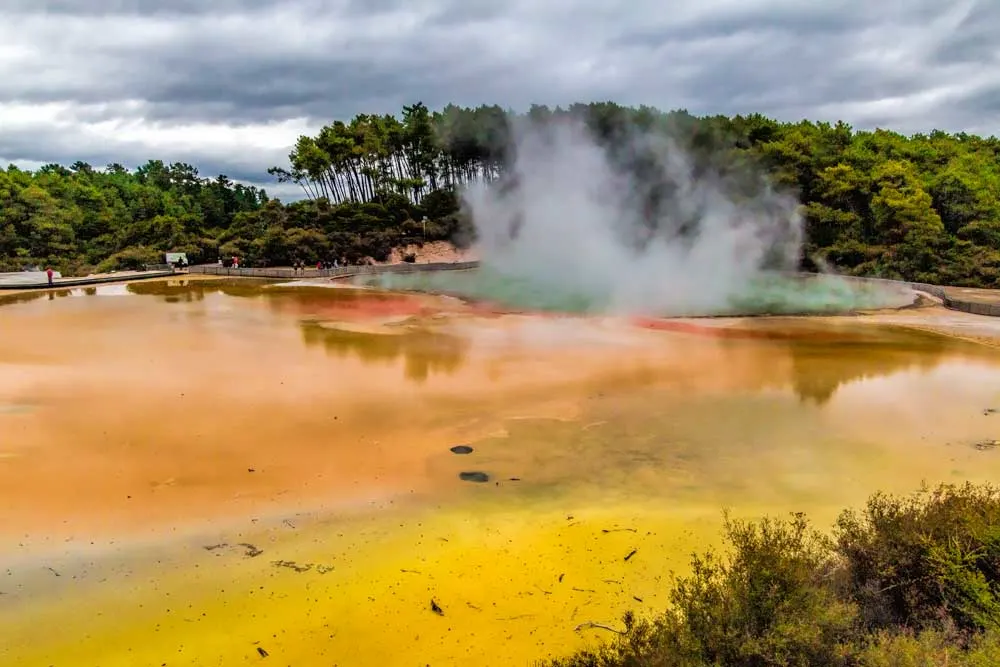
Within the reserve, you’ll see nature at it’s best, a dramatic geyser, vibrantly coloured lakes, silica terraces, a steaming waterfall and boiling mud to name a few. It truly is like wandering into another world.
Table of Contents
Why choose Wai-o Tapu
There are 5 major Geothermal Parks in Rotorua and the linked article discusses each of these and how to go about selecting which park or parks best suit your trip as few visitors will have the time or budget to visit them all.
For reference the 5 goethermal areas you’ll likely be considering are Whakerewarewa, Wai-o-tapu, Hell’s Gate (Tikitere), Waimangu and Orakei Korako (The Hidden Valley).
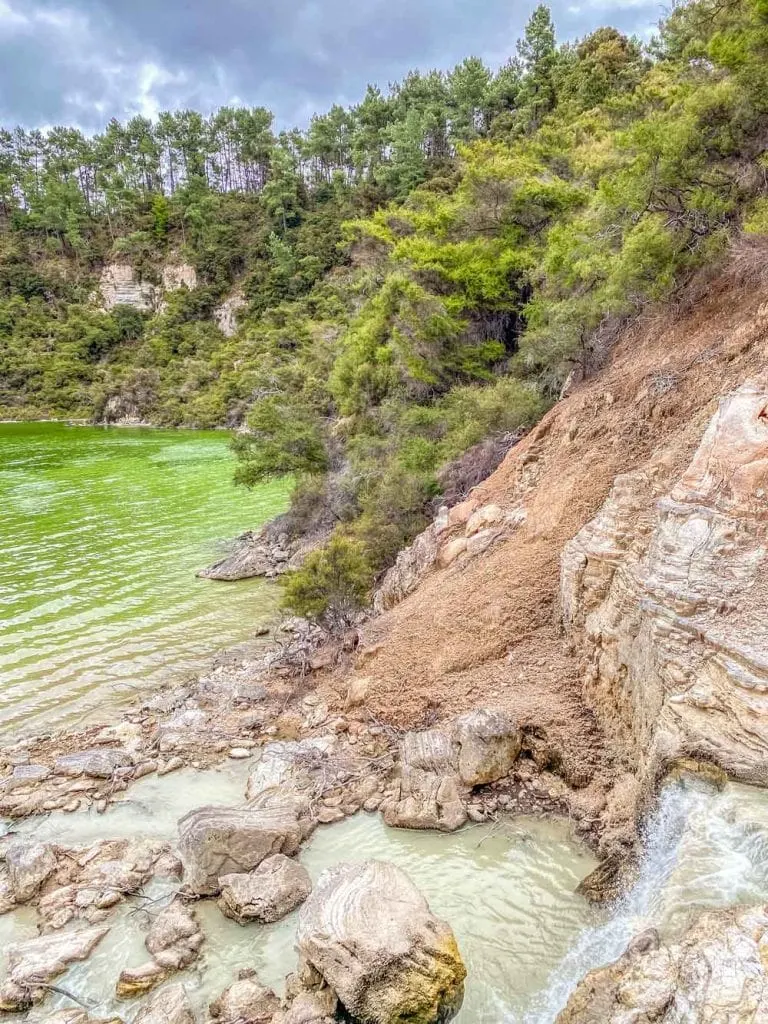
We’ve visited all 5 over the years and there are reasons why you might choose each of them but in this article, we focus in on a recent visit to Wai-o-tapu and why we recommend it for most local and international visitors.
The main reasons for choosing Wai-o-tapu are that it’s arguably the most picturesque with pools of vibrantly coloured water caused by the natural minerals, an impressive geyser that plays daily, easy mostly flat walking paths and a good diversity of geothermal activity and formations. We’ll go into several of these attractions in more detail below.
How long to spend at Wai-o-Tapu Thermal Wonderland
We’d recommend allowing half a day to spend at Wai-o-tapu to explore the full site including the geyser. There are 3 circuit walks, a 1 km, 2 km and 3 km but they overlap substantially so the full distance you’ll walk if you follow all the loops and side paths is closer to 4 km than 6.
If you are pushed for time and move at a consistent pace you could definitely do the full circuit in 90 minutes but if you want to see the geyser too and have time available to take it all in and linger at some of the viewing points then that extra hour or two would be well spent.
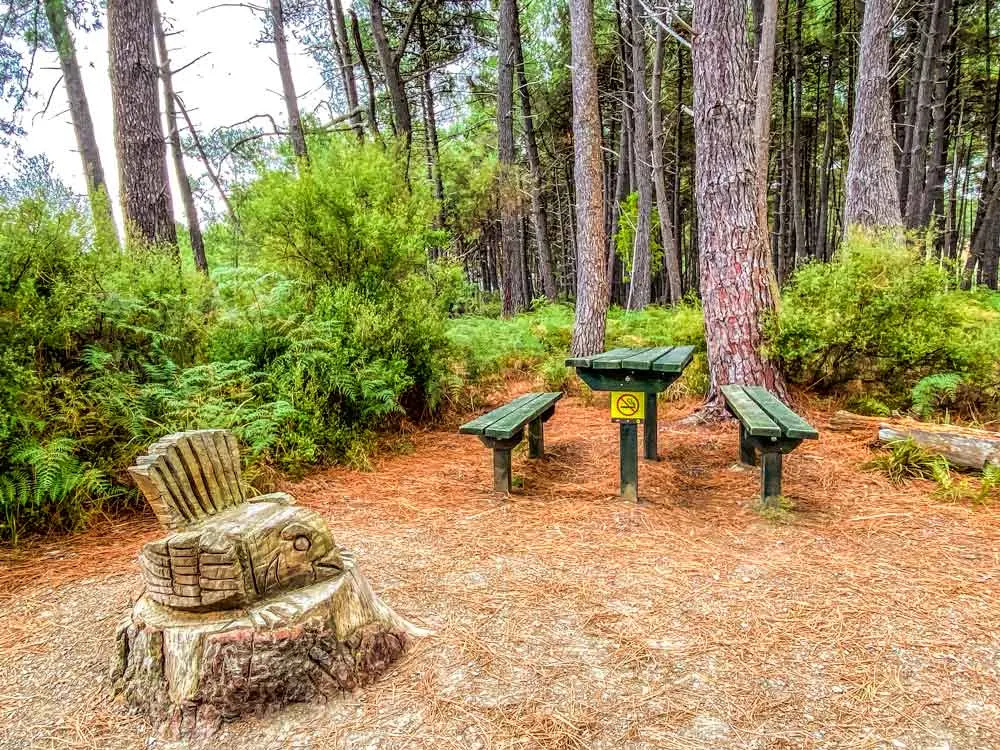
There is a picnic table at the far end of the second loop and you are able to take food into the park but the sulphurous smell is quite strong and most people will choose to have lunch later.
For maximum flexibility, we’d suggest exploring Wai-o-tapu independently rather than on a tour but as it’s around 25 minutes out of town and there’s not much else around this is really only practical if you have your own transport. Otherwise, there are shuttle options that include entry and transfers from your city accommodation or central points.
Check ticket prices for Wai-o-tapu Thermal Wonderland
The history and making of Wai-o-tapu thermal wonderland
New Zealand is a volcanic country. While the majority of the volcanos are now inactive or extinct, the geothermal activity is alive and bubbling below the surface. Nowhere is this more evident than Rotorua. It’s the major drawcard of the city for tourists, both domestic and from across the world.
The scenic reserve where Wai-o-tapu is located was formed around 160,000 years ago and is densely covered with collapsed craters, pools of boiling mud, naturally heated water that takes on dramatic colours from the mineral load and steaming fissures in the ground, rocks and hillside. The reserve extends over 18 square kilometres and loop tracks will take you through the most stunning of these.
Key attractions to watch out for
Once you have exchanged your ticket vouchers you pass through the gift shop and cafes. The toilet facilities here at the entrance are the only ones on site. Continue down the path and across the footbridge. Each point it sign-posted giving the name of the attraction and information about it.
The Craters
You start out the first loop in a clockwise direction with the craters, there are around 12 of them each 5 to 15 metres across and up to 20 metres deep. They are formed by acidic steam rising up from beneath the earth’s surface that eats away at it eventually causing it to collapse in.
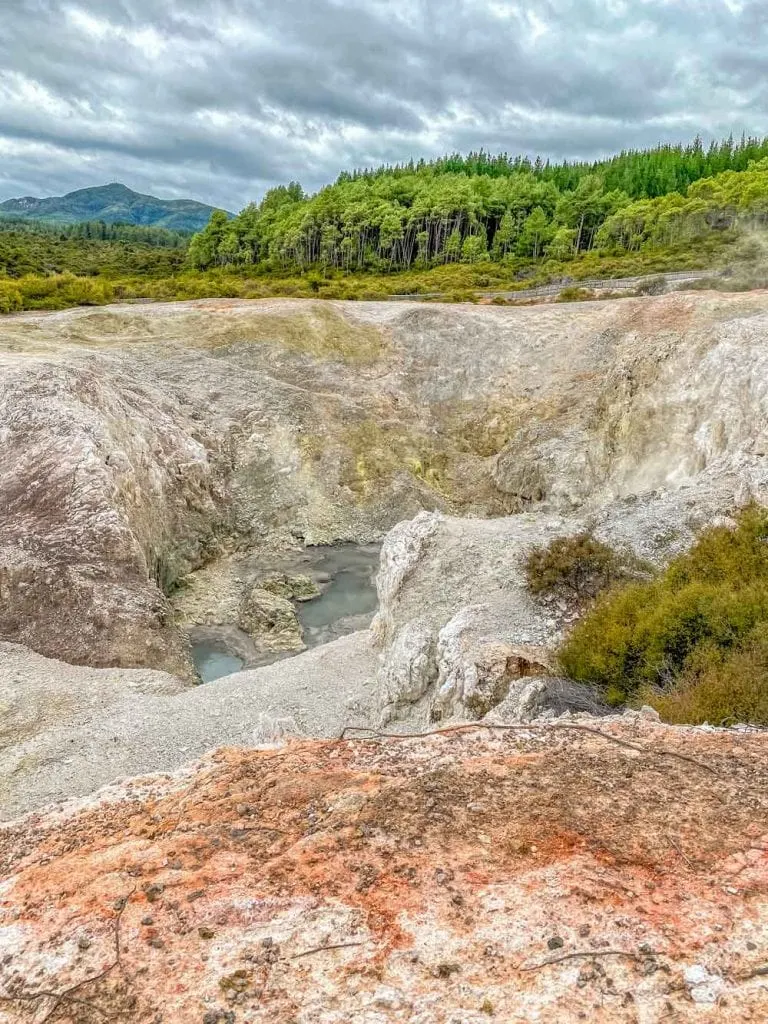
The craters and earth around them are tinged a variety of colours by the minerals in the steam that oxidise as they come into contact with the earth’s atmosphere creating hues of brown, purple, red, orange and yellow. At the base some are dry, others contain boiling mud, water and even crude oil.
The two I found most interested are actually on the far side as you are almost finished on the track, these are Rua Pumahu and Rua Owhanga, they are some of the larger ones but also have interesting side stories.
The crater of Rua Pumahu has boiling mud at the bottom, the Lord of the Rings trilogy used sound effects recorded here to create Mordor, the black volcanic plain in the south-east of Middle-earth. Incidentally, if you are a fan of LOTR or The Hobbit movies the Hobbiton Movie Set is an easy day trip from Rotorua and for a totally different experience, we can’t recommend it highly enough.
Rua Owhanga has been put to additional use by nature, you might see welcome swallows, starlings and mynahs flying around the crater or entering holes in the rock wall. They’ve built their nests in there and the heat that rises up helps to incubate the eggs and keeps the birds warm.
Artists Palate
This is the first of the colourful attractions you come to on the circuit and the huge cauldron is particularly dramatic with its many vibrant hues from yellows to ochre, orange, greens, turquiose and all the sutble blends in between surrounded by a native bush backdrop.
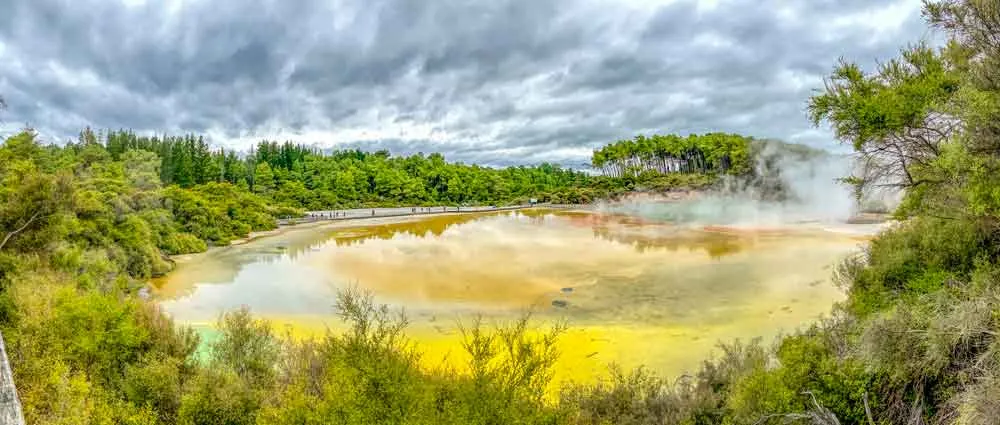
There are several spots to look down on or across the pool and it’s worth a stop at each, the light and placement of the sun make quite a difference to the colours and luminosity.
Champagne Pool
The champagne pool gets its name from the quantity of carbon dioxide that bubbles up from it similar to a glass of champagne, it’s also a rather special treat to enjoy but that’s where the similarities end.
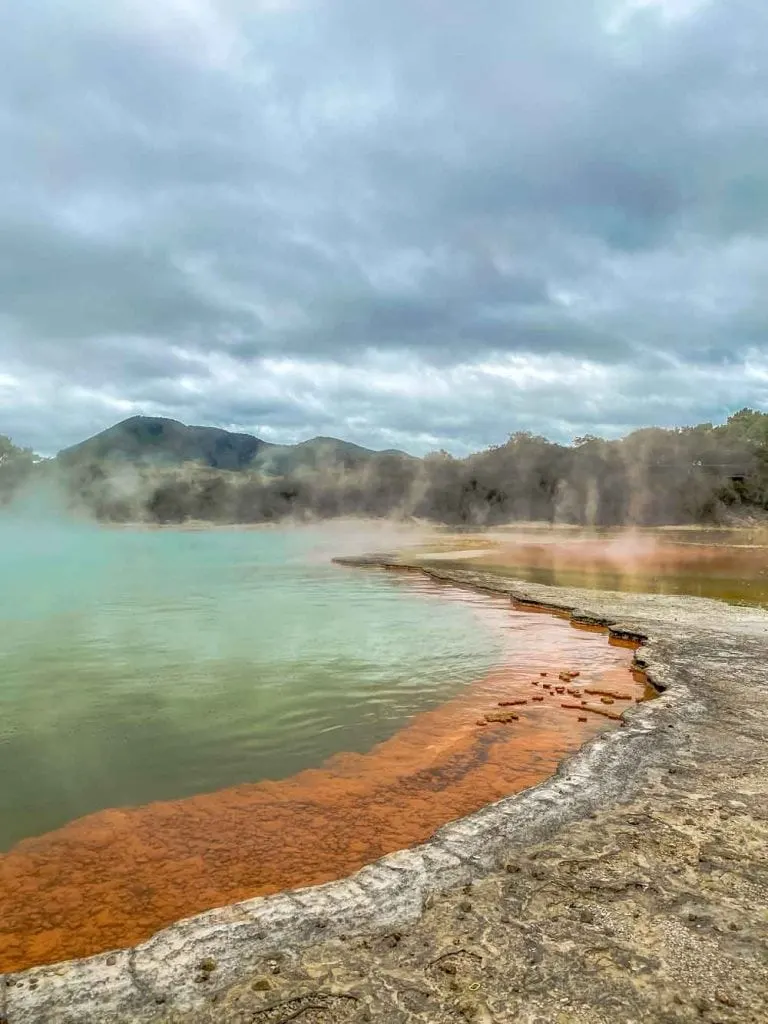
The dramatic colour in the outer ring come from orpiment, an arsenic and sulphite mineral with a deep orange-yellow hue. The hot spring is contained within a 65-metre wide crater that was formed during a geothermal eruption around 700 years ago. Holding 50,000 m3 of geothermal liquid it maintains a consistent temperature around 74° c after being cooled by the air.
Roto Karikitea (Devils Bath)
The iridescent green of the Devils Bath looks like it was created for Instagram by someone with a tendency to over amp the saturation but honestly, this is all-natural. Depending on the day, or more specifically the weather conditions, the luminosity and colour are perceived differently, from a vibrant lime to milky yellow-green but it is always like something from another world.
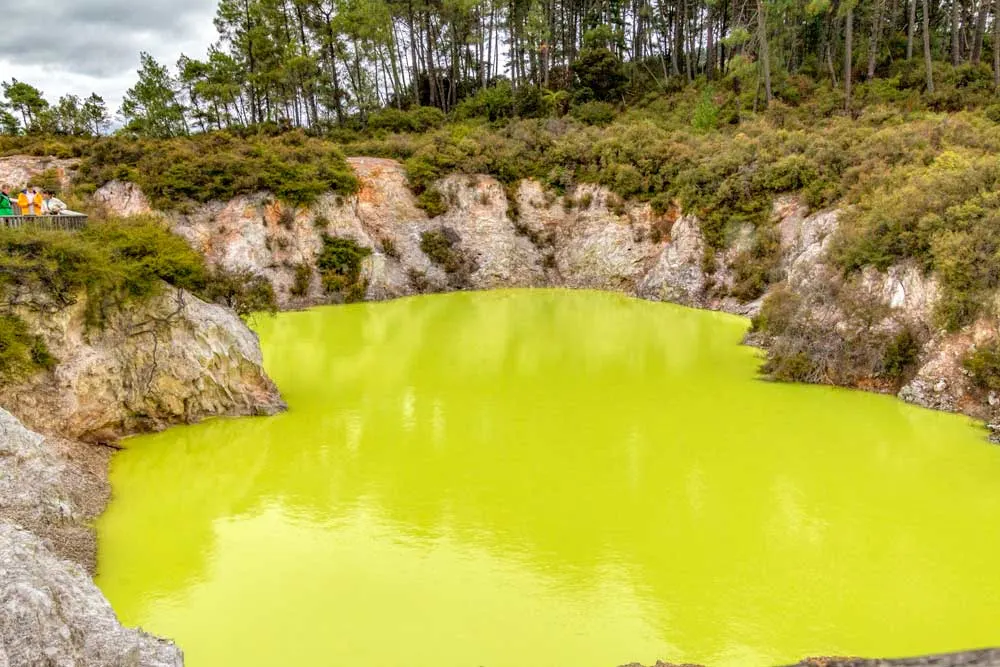
The origins of its common name, the Devil’s bath, isn’t known but many geothermal features around Rotorua allude to hell, demons and the devil in their names that date back to the 19th and early 20th century. It’s not hard to imagine that something so unnervingly abnormal and frankly dangerous would have attracted a moniker that would make it easily recognisable and serve as a warning.
The colour is caused by a combination of hydrogen sulphide gases and ferrous (iron) salts that filter through from the champagne pool and sit in suspension in the water refracting the light. While many of the surrounding pools bubble and steam this one is a very normal 14° degrees celcius, not at all unusual for lakes and oceans around NZ but with a pH level of 2 it’s very acidic.
Lake Ngakoro and the waterfall
You reach the far end of the trail on the shores of Lake Ngakoro. It’s a stunning jade green colour due to the elevated temperature from hot springs running into it that provide the perfect environment for an algal bloom. Not great swimming but surrounded by native bush it’s very beautiful.
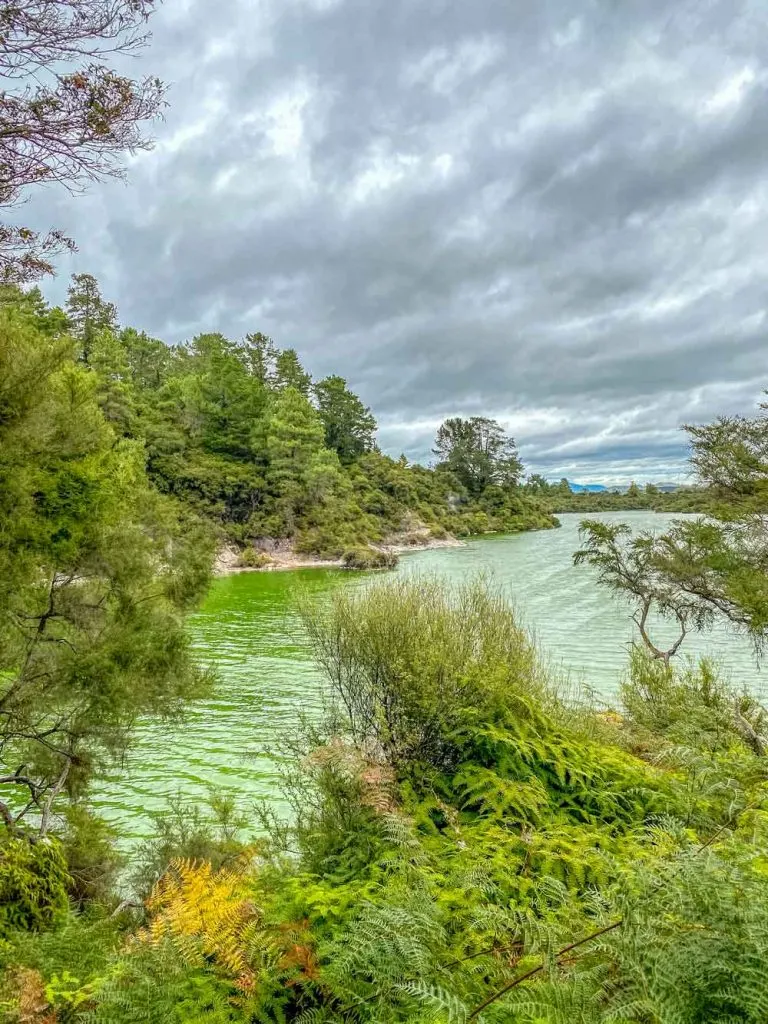
Around the edges you will see spots of boiling water rising up and into the lake or even the muddy edges spluttering up a few plopping bubbles.
The waterfall at its edge is called ‘Puna o Ngakoro’ and might be the only hot water waterfall you will ever see, depending on the ambient temperature you can often see it steaming as it flows over.
Sinter Terrace
Hot springs are laden with silica and as the shallow pools of water dry they leave a crust on the ground, this is what forms the stepped sinter terraces. The famous pink and white terraces were destroyed over a century ago when Mt Tarawera erupted but some of the best remaining examples are here at Wai-o-tapu.
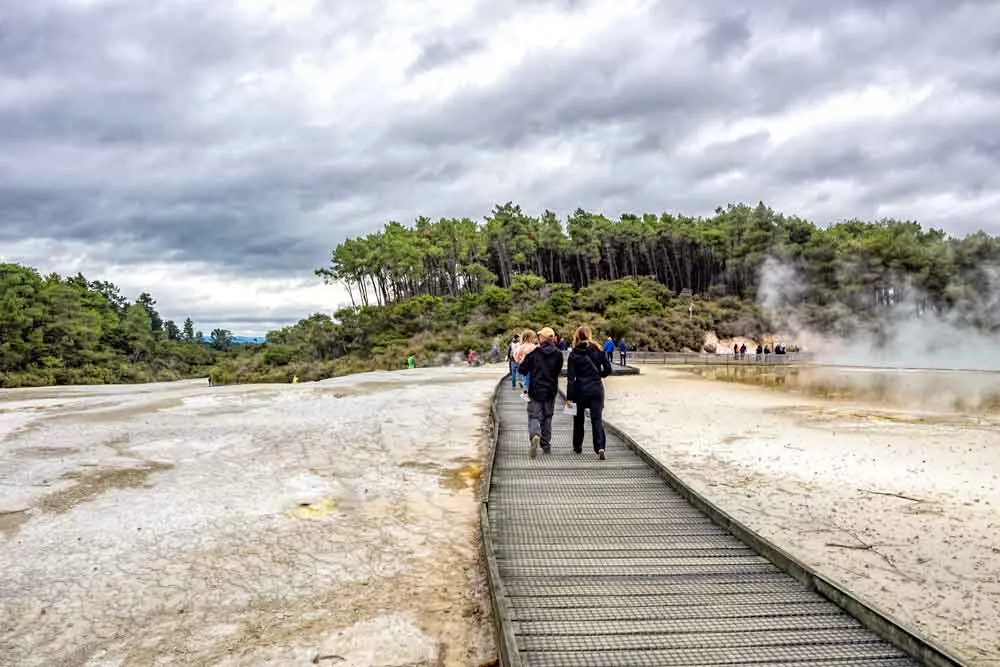
Take care to stay on the path, they are positioned to give the best view and the silica crust is very delicate so it’s easily damaged.
Lady Knox Geyser
The Lady Knox Geyser is also part of the Wai-o-tapu although it is slightly apart from the main site and has its own car park area.
The geyser erupts consistently at 10.15 am every day which makes it popular for tours that like to run to time and means that if you plan to be there you will definitely see it display. The negative is that nature doesn’t run like clockwork. A geyser erupts due to a pressure build-up of steam below ground when water is superheated when it comes into contact with magma rock.
To get the on-time eruptions they ‘trigger’ the geyser by tipping in soap powder that creates a chemical reaction disrupting that balance and off it goes with a high-pressure burst of water 10 – 20 meters into the air which you can watch from the amphitheatre. If you haven’t seen one before it is quite impressive.
There is uneasy debate locally about whether the daily addition of soap, even non-residue soap, into nature is environmentally the right thing to do. Soaping has been prohibited in other countries such as Iceland due to the environmental impact but for now, it is still allowed in New Zealand. There is also some concern around the practice being deceptive, did a tourist actually see a geyser eruption if it was artificially triggered?
Make your own decision and do what you are comfortable with. Either way, Wai-o-tapu is a fantastic geothermal area and one I’d add to a must-visit list if you are headed to Rotorua.
Wai-o-tapu map and layout
You’ll receive a guide map like the one below with your ticket on the day, I’ve included it here to help with a bit of early planning and to give an idea on the spacing of attractions along the route.
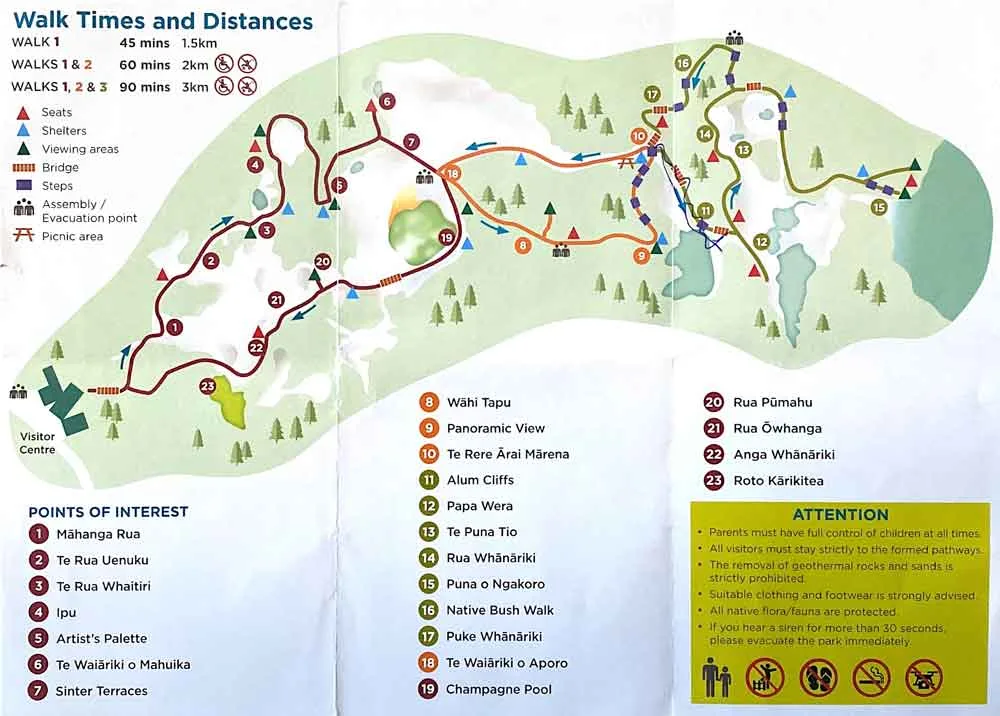
We did hear a few people who whizzed past us remarking that they would only do the first loop due to limited time and that there ‘wasn’t much to see on the others’. Don’t be mislead by the number of sites shown on the map, each loop is worth doing and most visitors would agree that scenic Lake Ngakoro and its waterfall (Puna o Ngakoro) at the far end are highlights not to miss. If you have the time and are able to walk the distance, it is all well worth seeing.
If you found this article useful please consider saving it to Pinterest. It makes it easy for you to find it again, it helps us, and it helps other travellers to find the information they are looking for.
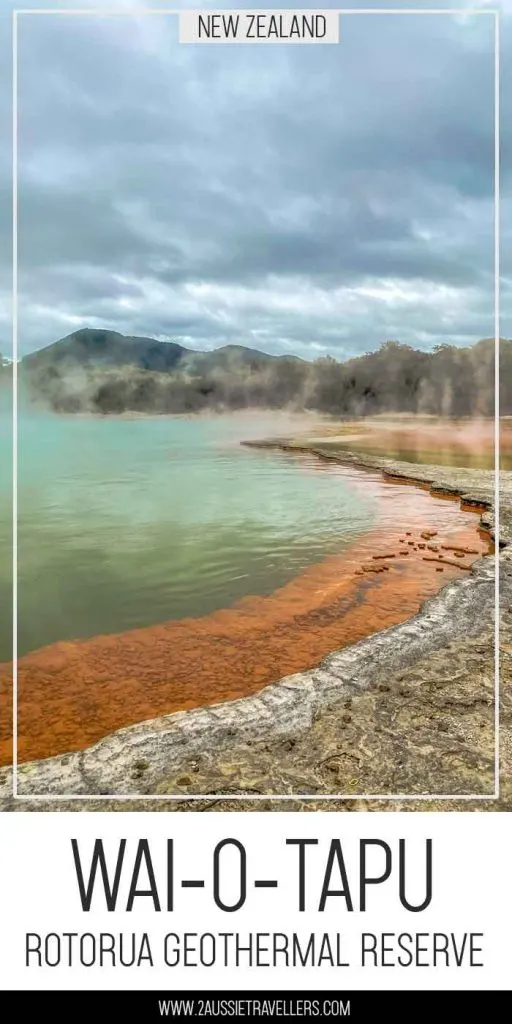
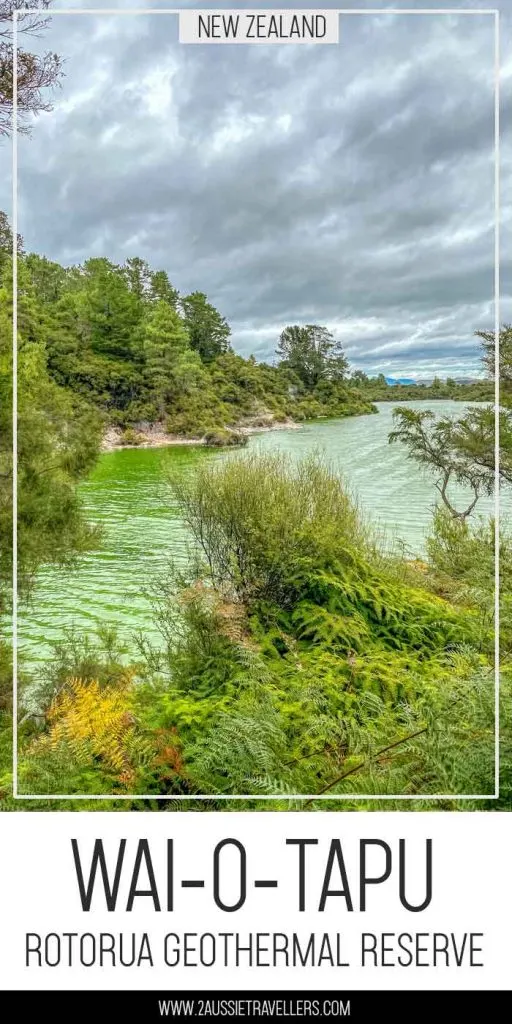
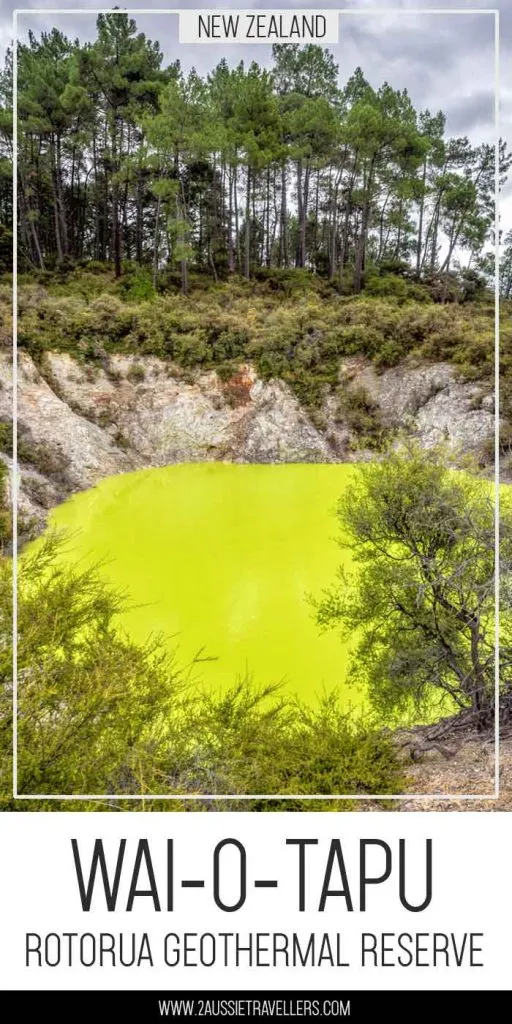
Vish
Tuesday 30th of May 2023
Hello, thanks for sharing the experience. Do you think we can take a kid of 4 years old? Also, is the stroller accessible on pathways? Cheers!
Toni Broome
Tuesday 6th of June 2023
Hi Vish, yes there are good paths through the top two loops at least, some are paved but most are boardwalk and gravel but there were several people with strollers when we were last there and they were getting around fine. The challenge if your 4 year old is quite active is getting them to hold your hand and stay with you, it's not a safe place for them to run off excess energy. While there are barrier fences on the big drops they are kept minimal for good visibility and you are asked to stay within the clearly defined viewing areas and paths both to avoid damaging the delicate structures but importantly for safety. I hope I don't put you off, we saw several children there, the steaming ground, bubbling mud and colours are magical for little ones.